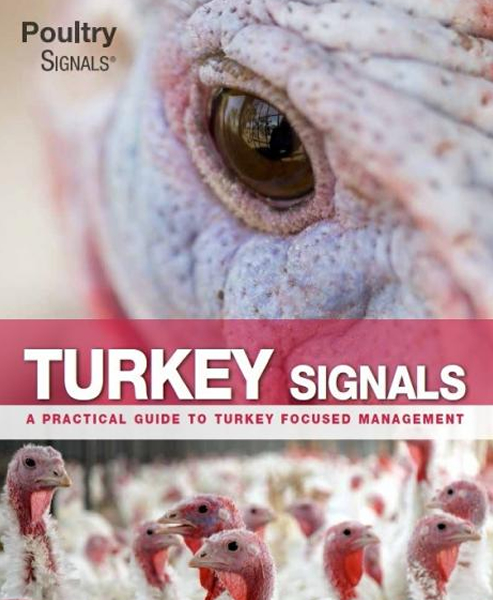
Turkey Signals
A practical guide to the targeted management of turkeys.
Author: Edward Mailyan
Pages: 200
| Paperback book | € 75,90 | |
| Online book | € 59,90 |
Example – Demo
Book: Turkey Signals
Globally, turkey production volume is relatively stable. Improving efficiency is the biggest challenge for every turkey farmer. This starts with reducing unnecessary losses. A dead turkey is a relatively high cost for a turkey farmer compared to a broiler chicken.
Turkeys live longer, so their death after 20 weeks of feeding and care is a significant loss…. Reducing mortality should therefore receive your full attention. Turkeys weigh on average twice as much as they did 75 years ago, and in a much shorter production time. This means higher demands on farmer skills and more focus on stress reduction for turkeys. Did you know that sick and weak day-old chicks will almost certainly die without your help. If you house them in a hygiene box, the mortality rate drops by 50%. Good care pays off!
Turkey Signals follows the cycle on a commercial turkey farm. The book describes how turkey-focused management can improve turkey production and welfare, and thus the turkey farmer’s financial results.
Turkey Signals is a practical guide that shows you how to recognise your animals’ signals early, how to interpret them and what measures to take. With over 850 hotographs and illustrations, this book is a must-have for anyone involved in turkey farming.
Knowledge you need to know
The background to this project is to improve turkey production. Turkey Signals is a practical book with information that everyone involved in turkey production should know. Certainly not a beautiful coffee table book, but a book with things to know.
Signals concept: See – Think – Act
Turkey Signals is part of the Poultry Signals series. The Signals concept always starts from observation and encourages the reader to think and act. This is the most important success factor of the Signals book series. Therefore, the information is presented very clearly. Practical knowledge comes first and complex theory is kept to an absolute minimum.
Book: Turkey Signals
Technical Information
ISBN: 9789087402624
Format: Hardcover
Dimensions: 20,5 x 26,5 cm
Pages: 200
Turkeys are constantly looking for reasons to die
The turkey is perhaps the most controversial, capricious and unpredictable species in poultry production. For historical and market reasons, until recently much less has been invested in turkey research than in chicken research. As a result, for example, there is still no optimal choice of equipment for different production systems. And some economically important diseases have not yet been fully researched and no effective prevention or treatment has been developed.
A relatively small group of professionals is working hard to make up for this lack of knowledge. They often say: ‘Turkeys are that kind of birds that are constantly looking for reasons to die’. Unfortunately, this is often the case: one day the flock looks good and happy and you seem to have the situation under control, but the next day it surprises you with an unexpected problem. All this, together with the lack of comprehensive management guidelines, makes the life of a turkey keeper very difficult at times.
The turkey is not a large chicken – it has fundamental differences that affect literally every aspect of management. If you have experience in poultry farming and think you can just switch from broilers to turkeys – that is a dangerous illusion – forget it and start from scratch! You will be surprised how different these species are, how much more attention and care turkeys need and how stress-prone and unpredictable they can be.
This is why Turkey Signals is so important. The book, the website and possible other ways of communicating knowledge all follow the ‘See – Think – Act’ approach. So you can better understand this unusual bird, optimise its management based on early detection of strange behaviour or early signs of disease, and so improve the welfare, performance of the flock and the financial results of the farm.
Edward Mailyan


